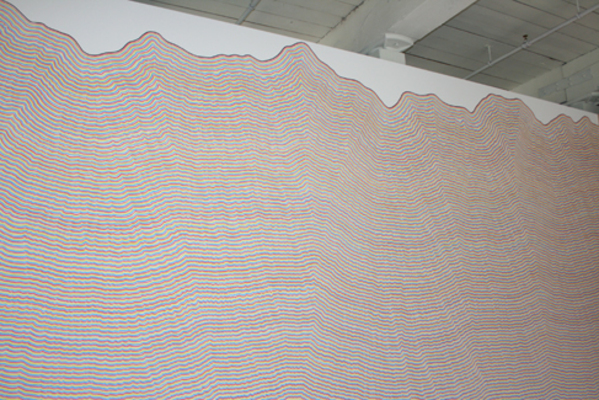
Description
Wall Drawing 797 was first created for the 1995 exhibit “In Two Worlds: Graphic Art by Modern Sculptors” at the Mead Art Museum, Amherst College. The drawing, conceived with student participation in mind, was first executed by four Amherst College sculpture students. The wall drawing represents a return to the linear repetition that Sol LeWitt explored in his wall drawings of the late 1960s and ‘70s. The instructions for the drawing direct draftsmen to copy, without touching, the line made by the previous draftsman. The repeated process becomes an exploration of the intricacies of the line. This reflects LeWitt’s belief that “The draftsman’s contributions are unforeseen by the artist…” 1 As the draftsman repeatedly copies the line, it becomes drastically altered from its original state – the smooth original line becomes more and more nervous as it is redrawn.
The ‘copy-line’ concept is not unique to Wall Drawing 797. In Wall Drawing 123, for instance, LeWitt instructs a first draftsman to draw a not-straight vertical line from the floor to the highest point on the wall that he or she can reach. Each of the following draftsmen copy this line, extending his or her lines as far as they can reach. Once all draftsmen have drawn a line, the process repeats. Other ‘copy-line’ drawings have been executed in conjunction with music.
Backstory
Before drawing the initial line, the head draftsman drew test lines on paper and copied them in order to see how the different lines would evolve. The line that he eventually chose to draw in black marker on the wall was inspired by the hills of the surrounding Berkshires landscape. Each copy of this undulating line took the draftsman between ten and twenty minutes to execute. The process of copying takes intense focus. If draftsmen feel that they are about to lose focus and deviate from the previous line, they take a break, making sure to start at the exact spot from which they lifted the marker.
Details
- Work Date:
- October 1995
- Medium:
- Red, yellow, Black, blue marker
- Credit Line:
- Courtesy of the Estate of Sol LeWitt (Designated for Yale University Art Gallery)